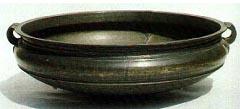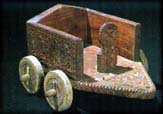Crafts
Earthenware
Unassuming and fragile,
earthen pottery nevertheless has a rich
tradition in India. In most States, the
potter fashions clay into pots, jars,
tumblers and platters of myriad shapes,
ornamental as well as useful. Except in the
rains, the village potter's wheel is never
idle. Like the weaver and the blacksmith,
the potter too is part of the traditional
village community.
Gujarat
provides cooking and storage pots painted in
red, black and white with geometric, floral
and animal patterns, Uttar Pradesh tall jars
with shiny black finish, Rajasthan highly
polished black ware for preserving oil and
ghee, the Kashmir Valley, Delhi and Jaipur
pottery with blue glaze and flowery motifs.
Villages
in the Eastern belt are mostly
made of mud and
especially in
Bankura, Bardhaman and
Birbhum districts,
temples have walls
of wonderful terracotta panels.
Images
of deities and
earthen lamps are also fashioned
out of
clay, especially at
the time of religious festivities.
In
Northern India, diyas
(small earthenware lamps) and
small clay icons of
Ganesha and Lakshmi flood the
market
around Diwali, the
Festival of Lights. |
 |
In
Bengal, life-size images of Sarasvati,
Lakshmi, Kali but especially of Durga
(astride a lion accompanied by her four
children, killing a demon) are made every
year with the utmost of care and decorated
with great splendour – only to be immersed
in the water after the act of worship.
Top

Metal
Ware

Ancient
India used to have an international
reputation for her brass and bell metal
work. The technology of metalworking had
been well developed by 2500 B.C. This
manifested itself in exquisite yet sturdy
images and icons in temples and household
niches, lamps, platters and other items
required for acts of worship, in gold,
silver, copper, brass, bronze, and other
mixed metals and alloys.
The
world-famous dancing figure of Nataraja, a
work in the Chola tradition, epitomises this
achievement. Villages from Tamil Nadu mould
and assemble brass oil-lamps (dipa),
standing as well as hanging ones, adorned
with decorative swans or women.
 But
what is even more remarkable is that many
everyday household equipments in India are
art objects. The kitchen ladle, the
nut-cracker, the water-pot, are all imbued
with the artistic spirit. The water-pot (ghara,
kalash, churru) itself can take on
myriad forms and shapes and have embossed
borders. But
what is even more remarkable is that many
everyday household equipments in India are
art objects. The kitchen ladle, the
nut-cracker, the water-pot, are all imbued
with the artistic spirit. The water-pot (ghara,
kalash, churru) itself can take on
myriad forms and shapes and have embossed
borders.
Benares
and Moradabad in Uttar Pradesh are famous
for their hand-made or hand-finished brass,
copper and even  stainless-steel
implements of traditional shapes. The
blacksmith is traditionally a most important
part of the village community. Tribal
metalware, for example that of Bastar,
Madhya Pradesh, is mainly of iron hammered
and twisted into oil lamps. stainless-steel
implements of traditional shapes. The
blacksmith is traditionally a most important
part of the village community. Tribal
metalware, for example that of Bastar,
Madhya Pradesh, is mainly of iron hammered
and twisted into oil lamps.
Top

Wood
Craft
Woodcraft
ranges from select temple
craftsmen to makers of
bullock-carts. In temples as
well as richer households,
there are carved wooden doors
and  door-posts.
Wooden gateways are found in
Orissa, Rajasthan, Gujarat and
Maharashtra. door-posts.
Wooden gateways are found in
Orissa, Rajasthan, Gujarat and
Maharashtra.
The
speciality of Tamil Nadu was
the vahana (temple
chariot), a massive structure
thick with delicate figurines.
|
| Andhra
Pradesh, Mysore and Karnataka
are famous for their elephants
and combs, carved mostly out
of sandalwood.
Many
havelis (mansions) of
Rajasthan displayed screens,
friezes, windows, and canopies
of wooden fretwork. Domestic
items like the karahi and the
khanta too are crafted out of
wood.
|
 |
Top

Textile
India had possessed
early the knowledge of cotton and fast
dyestuff. Dyed and patterned
cotton cloth from India has been
exported from pre-Roman times.
Karnataka
is famous for dyeing and weaving of
silk, Rajasthan for the dyeing of
cotton with indigo and alazarin.
Gujarat and Rajasthan have especially
developed bandhni work
(tying-and-dying of pinprick patterns
on woollen shawls and fine cotton
cloth). Block-printing with  the
help of wooden blocks and vegetable
dyes is another speciality of Sanganer,
Bagru, Jodhpur, Kota and other centres
in Rajasthan. Gujarat and Orissa are
renowned for ikat work (a
complex process where, before the
cloth is woven, the warp or weft
threads, or both, are bundled and
bound with bands resisting dye-stuffs,
and then repeatedly dyed to create
bands of patterns). the
help of wooden blocks and vegetable
dyes is another speciality of Sanganer,
Bagru, Jodhpur, Kota and other centres
in Rajasthan. Gujarat and Orissa are
renowned for ikat work (a
complex process where, before the
cloth is woven, the warp or weft
threads, or both, are bundled and
bound with bands resisting dye-stuffs,
and then repeatedly dyed to create
bands of patterns).
In
Gujarat there used to be a thriving
centre of silk patola saris of
double ikat work in Ahmedabad,
Surat, Patan etc. Sambalpur and
Cuttack in Orissa, Pochampalli,
Chirala and Puttapaka in Andhra
Pradesh are still flourishing centres
of ikat textiles.
West
Bengal has the tradition of
exquisitely spun and woven jamdani,
baluchari, dhanekhali and
shantipuri saris.From
Kutch and Kathiawar in Gujarat come
embroidery for doorway friezes, bags
and garments. From Mathura and
Vrindaban in Uttar Pradesh come
metal-thread work.
North
Eastern hill tribes turn out colourful
shawls of patterns that are
distintively their own. Kashmir
provides the world with finely
embroidered soft woolen shawls and
carpets with wonderful designs, both
using the paisley motif as a kind of
trademark.

Top
|